|
So how does
it all work?
The Power Tank runs on CO2. Yup, that
same stuff you're exhaling right now as you read this. But you can't
just blow into your tires and have them inflate like a balloon,
right? Of course not! The difference is that the Power Tank runs
on liquid CO2. Liquid CO2
is what is used for soda fountains to add that wonderful fizz. Unlike
the CO2
you're exhaling,
as liquid
CO2 expands,
it provides tremendous pressure.
 To
fill the Power Tank, you will need to find someone who specializes
in the CO2 business, like a fire extinguisher
shop, welding supply house, or (in our case) a beverage CO2
supplier. We take our tank in, they pop the regulator off, empty
any remaining CO2, weigh the tank, and then
add 10 pounds of CO2. We're in and out in
just a few minutes and they only charge us five bucks! I think our
supplier is a bit on the cheap side. You may find it more expensive
in your area. To
fill the Power Tank, you will need to find someone who specializes
in the CO2 business, like a fire extinguisher
shop, welding supply house, or (in our case) a beverage CO2
supplier. We take our tank in, they pop the regulator off, empty
any remaining CO2, weigh the tank, and then
add 10 pounds of CO2. We're in and out in
just a few minutes and they only charge us five bucks! I think our
supplier is a bit on the cheap side. You may find it more expensive
in your area.
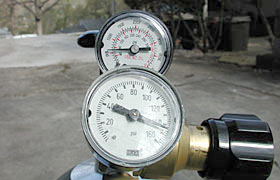 From
there, the rest is pure science. But don't get too discouraged,
as this is pretty easy to understand and we won't be grading you
later. The liquid CO2 evaporates inside
the tank and builds up pressure. The gas goes to the top of the
tank and as you release the gas, more CO2
is allowed to evaporate. So what you have is a constant turn-over
of liquid to gas within the cylinder. When the gas reaches 500-900psi,
it stops evaporating until more gas is released from the tank. Our
tank pressure usually hovers around 500-600psi. The evaporation
process allows a constant supply of gas until the tank runs out,
which means your last bit of air has about the same pressure as
the first. From
there, the rest is pure science. But don't get too discouraged,
as this is pretty easy to understand and we won't be grading you
later. The liquid CO2 evaporates inside
the tank and builds up pressure. The gas goes to the top of the
tank and as you release the gas, more CO2
is allowed to evaporate. So what you have is a constant turn-over
of liquid to gas within the cylinder. When the gas reaches 500-900psi,
it stops evaporating until more gas is released from the tank. Our
tank pressure usually hovers around 500-600psi. The evaporation
process allows a constant supply of gas until the tank runs out,
which means your last bit of air has about the same pressure as
the first.
What's so great
about using CO2 is that A PT-10 POWER TANK
is less than half the size of a 5 gallon air tank yet it will hold
as much as 20 times the energy of a similar tank using ambient air.
A 5-gallon air tank pressurized to 125 psi will only air up two
33x12.5" truck tires from 10 to 20 psi.

Though the
inside won't freeze up on you, the regulator and coupler will
get chilled and ice over. Be careful when you touch it! |
As far as safety
is concerned, the 6061-T6 aluminum cylinder is rated for 1800 psi
with a maximum pressure rating of 3000+ psi. At 3000psi, there is
a built-in pop-off valve which will automatically relieve the pressure
in the tank.
To use the tank,
hook up your air hose to the coupler and turn the big black knob
on the top of the tank. This knob turns the flow of air on and off.
Usually, just a crack of the knob is all that's needed to get plenty
of pressure. The regulator takes care of the pressure going out
the hose. For airing up tires, you'll get a good feel for a pressure
that's comfortable for you. If you get the pressure too high, it's
possible that the air chuck will come flying off of the tire, so
be careful. It's a good idea to not let go any time you're filling
tires, anyway. For air tools, you will want to run over 100psi.
We usually go to around 120 or so on ours. Again, be careful to
not over-torque whatever you are working on.
The Power
Tank System (a closer look)
The Power Tank system consists mainly of the tank, the regulator,
an air hose, handle/guard, and ball-end air connector. If you want
to run air tools, you'll need to get a quick-release coupler, as
well. In order to assemble everything, you'll need some standard
wrenches, and we recommend Teflon tape to really seal up all the
connections.
| Putting
Together the DuraThane Hose |
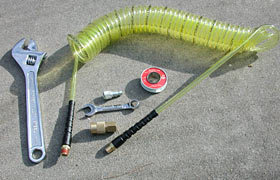
The basics you'll need to get going. |

A 9/16 wrench is useful for assembling the coupler. |
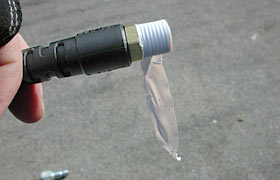
Though the ends have thread-locker on them, we used Teflon tape
in order to ensure a good seal. |
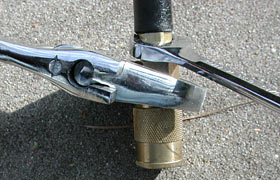
Installation of the coupler is easy. |
| Installing
the SuperFlowTM
Regulator |

Here is the SuperFlowTM Regulator. It
is precision-designed and is made in such a way that it won't
freeze up during extended usage, like less-expensive regulators. |
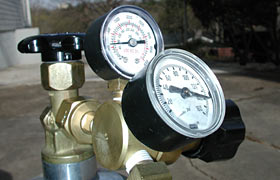
The back guage shows the pressure inside the tank. The front
guage shows the working pressure. Turning the knob raises or
decreases the pressure flowing through the regulator. |
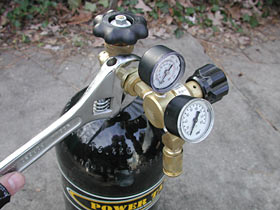
The regulator attaches easily to the fitting on the top of the
Power Tank. It is removed when filling. |
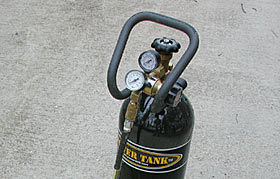
The included handle is quite handy. It clamps on to the top
of the Power Tank using two, large, Allen-head screws. The handle
is comfortable and also acts as a guard. |

The big knob on top of the tank simply turns on and off the
flow of air to the regulator. |
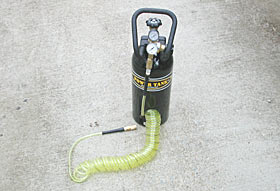
The completed Power Tank. |
Final
thoughts and comments --->>>
|

 To
fill the Power Tank, you will need to find someone who specializes
in the CO2 business, like a fire extinguisher
shop, welding supply house, or (in our case) a beverage CO2
supplier. We take our tank in, they pop the regulator off, empty
any remaining CO2, weigh the tank, and then
add 10 pounds of CO2. We're in and out in
just a few minutes and they only charge us five bucks! I think our
supplier is a bit on the cheap side. You may find it more expensive
in your area.
To
fill the Power Tank, you will need to find someone who specializes
in the CO2 business, like a fire extinguisher
shop, welding supply house, or (in our case) a beverage CO2
supplier. We take our tank in, they pop the regulator off, empty
any remaining CO2, weigh the tank, and then
add 10 pounds of CO2. We're in and out in
just a few minutes and they only charge us five bucks! I think our
supplier is a bit on the cheap side. You may find it more expensive
in your area. From
there, the rest is pure science. But don't get too discouraged,
as this is pretty easy to understand and we won't be grading you
later. The liquid CO2 evaporates inside
the tank and builds up pressure. The gas goes to the top of the
tank and as you release the gas, more CO2
is allowed to evaporate. So what you have is a constant turn-over
of liquid to gas within the cylinder. When the gas reaches 500-900psi,
it stops evaporating until more gas is released from the tank. Our
tank pressure usually hovers around 500-600psi. The evaporation
process allows a constant supply of gas until the tank runs out,
which means your last bit of air has about the same pressure as
the first.
From
there, the rest is pure science. But don't get too discouraged,
as this is pretty easy to understand and we won't be grading you
later. The liquid CO2 evaporates inside
the tank and builds up pressure. The gas goes to the top of the
tank and as you release the gas, more CO2
is allowed to evaporate. So what you have is a constant turn-over
of liquid to gas within the cylinder. When the gas reaches 500-900psi,
it stops evaporating until more gas is released from the tank. Our
tank pressure usually hovers around 500-600psi. The evaporation
process allows a constant supply of gas until the tank runs out,
which means your last bit of air has about the same pressure as
the first.









